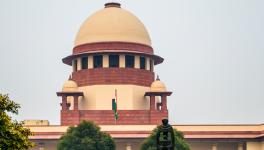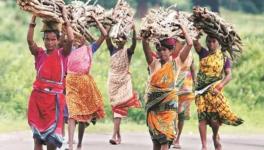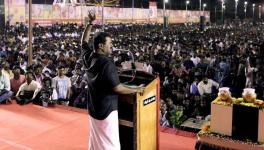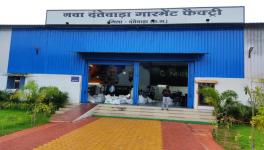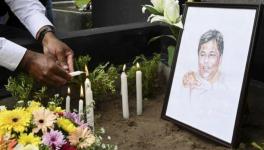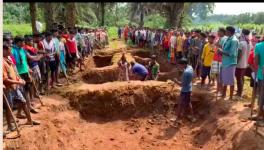Shooting the Messenger: Life and Death of Journalism in the Bastar Forest
This article is based on Suvojit Bagchi’s reports from Chattisgarh for The Hindu and few of his recent presentations on conflict in south Chattisgarh.
My presentation is on the challenges faced by the journalists, especially of the Hindi language press, working in Chattisgarh State in central India.
South Chattisgarh’s Dandakarnya area is about 40,000 square kilometres in size – nearly as big as Netherlands or Kerala – and very sparsely populated, mostly inhabited by Gond tribals. Since the 80s this area has witnessed a leftist armed movement. In response to which the police and paramilitary stepped-up their operations from time to time. This has been the story in south Chattisgarh since Independence. Even before the Maoist party was formed in the late 1960s, police action on the tribals was a routine affair.
Let us look at a paper clipping from an English language newspaper, Dandakarnya Samachar, published in 1961.
The newspaper was full of such news at the time. So, in 1961, when the Indian State was not half as powerful as now, the government did not stop such reports from rolling out, reports which were directed against the police. However it is far more difficult for the local press to publish such reports today saying “police opened fire”. Such newspaper reports from the early 1960s establish that long before even Maoist or Naxalite parties were formed, such police action was commonplace in Bastar division in south Chattisgarh. I have many newspaper clippings to establish this fact.
Kamal Shukla is a prominent journalist in south Chattisgarh who routinely talks about rights of the journalists in Chattisgarh. He told me last week that it is impossible for scribes to enter a village when a shootout occurs in which innocent villagers are killed, especially when it is by the police.We, in India, call them encounter killings. A journalist’s key job in a conflict area is to identify a “fake” encounter from a “real” one. Fake is one when a person is killed point blank without an exchange of fire, whereas the real one is when a genuine exchange of fire takes place between the police and the insurgents.
Dandakarnya is a huge area, an extremely hostile terrain with hardly any motorable road inside the forest areas, dotted with camps of joint forces. So it is an exceptionally difficult job for a journalist to (a) develop his/her contacts to get an access inside the forest (b) convince the contact to take him/her inside as its extremely risky for the person who is permanently residing in the area (c) to evade the paramilitary force to walk 20-30 kilometres to reach a village in extreme weather and (d) to convince your editor to give you a week or more to go inside the forest to investigate one story of killing or a rape.
It indeed is a luxury to propose one story in a week in a newspaper. However, time is a significant factor for an in-depth and nuanced story.Any serious and sincere journalist needs time and financial and professional support from his/her newspaper to venture into hostile territory. Without such institutional support it is impossible to work in – forget Bastar – in any place of conflict. It is impossible for freelancers to operate freely in Bastar and central Indian conflict areas – which also is the mining and tribal India – the poorest part of India, stretching over six states: eastern Maharashtra, southern Chattisgarh, north Telangana, west-south Odisha, western Jharkhand and west-south Bengal.
Kamal Shukla, while attempting to reach Sulenga village in Bijapur district (in the extreme south), was detained by the police. This was on the February 19, two weeks after the death of a villager Hedma Ram. Shukla was trying to investigate Hedma Ram’s death.He was later threatened and told that he would be arrested. After a month he tried to re-enter the village with a well-known English language television journalist and he was successful.
Without entering Sulenga village Shukla would have never known that Hedma Ram, who was killed in a fake encounter was not a Naxalite but the brother of one who was. The Hindu has reported this incident in May in the context of another story. Actually, there was no real encounter. Hedma Ram was simply picked up on February 2 and killed. The police said that there was an award of about one lakh rupees on him as he was a “dreaded Naxalite”. Hedma Ram was in jail for two years on a fake charge for not getting his brother arrested. After being acquitted by the court he was declared a Maoist – and a "dreaded one" – and shot within a week of his acquittal.
Had he not been to the village Shukla would have never known that a man turned into a “dreaded Naxalite” within a week of his acquittal from all charges and was so dangerous that he had to be eliminated.
If one investigates the arrests or encounter killings on a case by case basis one would find that an overwhelming majority of cases against the tribals are fake. That is why it is dangerous for the police to let the local journalists enter the villages to unearth the truth.
So if one investigates the arrests or encounter killings on a case by case basis one would find that an overwhelming majority of cases against the tribals are fake. That is why it is dangerous for the police to let the local journalists enter the villages to unearth the truth.
Police wants the journalists to report everything – from the condition of schools or health centres in interior areas, surrenders of insurgents, alleged rapes or fake encounters – but on basis of police hand outs and press statements. They do not want journalists to visit the family of the victims.
If the journalists keep on challenging the administration, as they do by keeping on entering villages to investigate – after a point their houses will be ransacked and finally they will be arrested under a draconian state law.
Journalist and former Chattisgarh chief of ICRC Malini Subramaniam’s house was ransacked and she left south Chattisgarh while, Somaru Nag, Santosh Yadav, Prabhat Singh and Deepak Jaiswal were arrested over last one year. The last two – Singh and Jaiswal – even met chief minister Raman Singh with an appeal to create an atmosphere where fair journalism can be practised. The chief minister promised to create space for journalists. What in fact happened was that they were promptly arrested soon after meeting the CM. One of them has got bail only recently.
It is not only journalists; social activists, lawyers, legal activists, doctors and ordinary who are being monitored and pressurised. The judges are also being systematically harassed by the police – for stating that some of the tribals are wrongly implicated. In this context kindly refer to the series of reports published by Jagdalpur Legal Aid Group on the legal and illegal modes of harassment of the Bastar tribals.
It is not only journalists; social activists, lawyers, legal activists, doctors and ordinary who are being monitored and pressurised. The judges are also being systematically harassed by the police – for stating that some of the tribals are wrongly implicated. In this context kindly refer to the series of reports published by Jagdalpur Legal Aid Group on the legal and illegal modes of harassment of the Bastar tribals.
It is also important to highlight that I lost a dear friend Sai Reddy, an excellent reporter and analyst, to this ongoing conflict. Reddy was hacked to death by the Maoists who later claimed that he had helped the police to put in place a vigilante force in south Chattisgarh that killed many tribals. Later, many leaders from Maoist party’s central committee or politburo told me that it was a mistake to kill Reddy and that they acknowledge their mistake. While the outlawed party has not targeted any journalist after Reddy’s killing in 2013, the security forces keep harassing the scribes. Interestingly, in 2008, Reddy was arrested by the state police and charged under the Special Public Security Act of Chhattisgarh for his alleged connection with the Naxalites.This treatment has been meted out to many other journalists and civil society activists of Chhattisgarh
Here, it may not be out of context to quote from a concept note for a seminar that I recently addressed. The note prepared by Delegation of the European Union to India reads:
“An issue of concern is also protection for journalists when they cover emergencies. The Geneva Conventions and their Additional Protocols contain only two explicit references to media personnel [Article 4 A (4) of the Third Geneva Convention and Article 79 of Additional Protocol I] but, read in conjunction with other humanitarian rules, journalists have a comprehensive protection under the existing humanitarian framework. Article 79 provides journalists all rights and protections that are granted to civilians in international armed conflicts. The same holds true in non-international armed conflicts by virtue of customary international law (Rule 34 of the ICRC’s Customary Law Study). Journalists’ right to life, liberty, security and freedom of expression are all protected under the various Articles of the Universal Declaration of Human Rights.”
The routine harassment of journalists reminds me of the comment by Adele Balasingham, wife of Anton Balasingham, who worked among LTTE in north and east of Sri Lanka for many decades. When journalists were targeted by Indian Peace Keeping Force (IPKF) in Sri Lanka before the aerial attacks commenced, Ms Balasingham wrote that the “world’s largest democracy carried out the heinous crime of striking down the very instrument of democracy, the media of the people of Jaffna, to stifle their freedom of opinion and expression.” The state perhaps has now decided to “stifle” freedom of expression inside its border, in Bastar, so such military operations can be conducted freely.
However, there are also journalists who obediently report as the security forces want them to.
And those who listen to the police and report from press briefings get many awards: road construction contracts, government building contracts and above all pay packets from the police.
In rural India, most of the papers and TV channels do not pay their reporters in Hindi or other local languages in the districts. They ask their reporters to raise funds from companies, from the local administration or traders.
Now, you may ask, why their respective media houses, some of which are national brands, never question such violation of media ethics. For two reasons:
1. Most of these papers do not pay their journalists. I repeat, in rural India, most of the papers and TV channels do not pay their reporters in Hindi or other local languages in the districts. They ask their reporters to raise funds from companies, from the local administration or traders. The terms of employment are simple: Deposit a percentage of your collection as ad-revenue, also look after the circulation. So the reporter in many parts of rural India is a reporter- cum-sales person-cum-circulation manager, thus aligning his personal and company’s interest, in violation of all media ethics.
This is precisely the reason why a newspaper or a television channel can always disown its journalists when they are arrested saying that the journalist is an ad-sales person or a freelancer who is not on the company’s pay roll. The fact is that hardly any of the staff in the remote areas in the districts is on the company’s pay roll. In states like West Bengal, for example, where the crisis is not as acute, this is not a major issue. But in a conflict area such a policy of the media house is traumatic for the journalists who end up in jail for several months or years for being not backed by respective media houses.
2. Secondly, the newspapers or media houses get leases of iron ore, bauxite or coal mines themselves, making it virtually impossible for them to criticise any of the government’s policies. Imagine a situation when the media houses, which are expected to write against the government, are acquiring mines from the same government against whom they are expected to write. So, they do not mind if their reporters incarcerate in jail as their objective is not journalism but mining. And let us not forget that some of these papers and television channels are well-known national brands deciding national policies from terrorism to fiscal deficit. There is absolutely no monitoring of these papers or channels as to what are they producing and how are they treating their reporters.
In a situation like this, with the trauma and helplessness of the adivasis remaining hidden from the rest of the world, as journalists are censured, the Bastar tribals have slowly started etching their stories on memorial plaques which they call Mritak Sthamv.
In this context, we journalists or at least I had some hope from the English language press – print and television – as the local administration takes it little more seriously.
Unfortunately the English language press has failed to realise the scale of this tragedy in the Maoist, mining and tribal heartland of India. According to official figures 3,000-4,000 people have died here over the last five-six years. The unofficial death toll is far higher. If a traffic signal does not work on Lodhi Road for half-an-hour, perhaps 20 reporters will assemble. However, thousands getting killed, raped or going hungry in tribal India doesn’t get reported by the English press. The reason being none of the English press has a full-scale bureau or even a correspondent in Dandakarnya.
In a situation like this where the trauma and helplessness of the adivasis remains hidden from the rest of the world the Bastar tribals have slowly started etching their stories on memorial plaques which they call Mritak Sthamv.
As we reported in The Hindu a few days ago, villagers in the heavily militarised areas of south Chhattisgarh “have embraced the traditional Gond art to document fake encounters that are not uncommon in that part of India. The last moments of Gond tribals, as they are killed by the security forces, are narrated on stone plaques. Kamal Shukla, the journalist who has documented such plaques says that he has never come across such unique storytelling earlier.
Time will tell whether this unique storytelling on memorial plaques will evolve as a form – which is unusually similar to the paintings of 19th century artists of Bengal called Potuas, to a layman like me – or disappear with time. But it is a fact that at the moment such storytelling is evolving because the traditional 20th century forms, to document an event using a camera or a note pad and pen are blocked. The story published in The Hindu, on Mritak Sthamv may be read here.
To end, I would quote John Pilger: “Journalism, not truth, is the first casualty of war”. So it is in south Chattisgarh.
(Suvojit Bagchi has covered conflict in south Chattisgarh for the BBC World Service and The Hindu).
Cover Photo Courtesy: Kamal Shukla
Disclaimer: The views expressed here are the author's personal views, and do not necessarily represent the views of Newsclick
Get the latest reports & analysis with people's perspective on Protests, movements & deep analytical videos, discussions of the current affairs in your Telegram app. Subscribe to NewsClick's Telegram channel & get Real-Time updates on stories, as they get published on our website.









